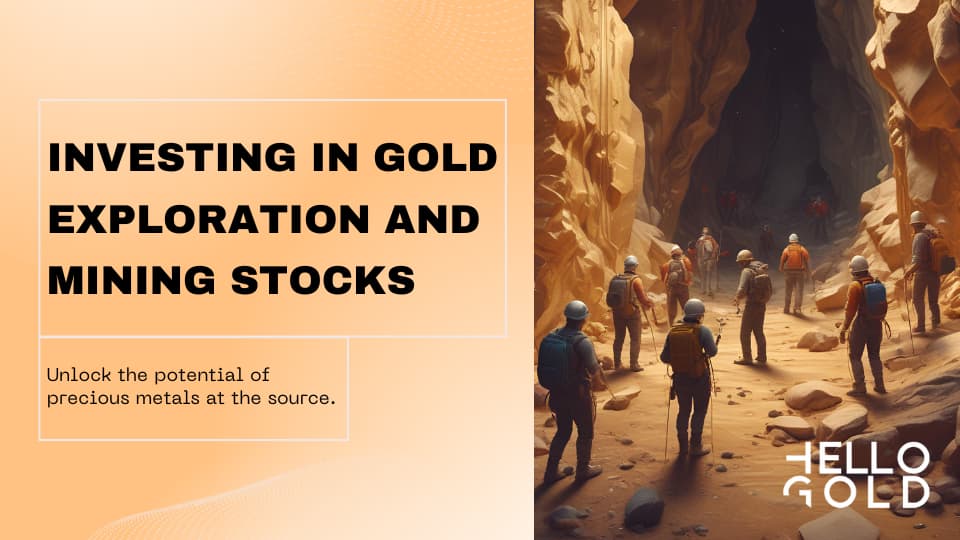Gold mining stocks can be a powerful addition to your investment portfolio, but they come with unique risks and opportunities.
This comprehensive guide breaks down the basics of investing in gold mining companies. You’ll get insights into the potential rewards as well as the hidden problems that could impact your financial future.
Get the knowledge you need to make smart choices in this alternative investment area.
The Gold Mining Life Cycle
Gold mining is a complex, multi-stage process that spans decades and requires substantial financial investment, cutting-edge technology, and careful management of environmental and social impacts.
For those considering gold mining stocks as a way to diversify their portfolio, a thorough understanding of this lifecycle is essential. Each stage presents distinct risks and opportunities that can dramatically influence a company’s profitability and stock performance.
Exploration: Searching for Potential Gold Deposits
Exploration is the initial and often most risky stage of the gold mining life cycle. It’s a high-stakes effort that can last anywhere from 1 to 10 years or even longer, according to industry data.
Mining companies use a variety of techniques to locate potential gold deposits, beginning with traditional prospecting methods.
Geologists start by analyzing historical mining data, geological maps, and satellite imagery to identify areas with promising gold mineralization features.
They then conduct field visits to examine rock outcrops and collect surface samples.
This early work guides companies in deciding which areas warrant further investigation.
Once promising areas are identified, companies must stake claims or acquire mineral rights.
This process varies by location but typically involves registering with government authorities and paying fees to secure the right to explore and potentially mine a specific area.
Proper claim staking is crucial to avoid legal disputes and protect the company’s interests.
As exploration progresses, companies employ increasingly advanced techniques.
Geophysical surveys, such as aeromagnetic and induced polarization surveys, provide valuable underground information without the need for drilling.
These methods can detect variations in rock properties that might indicate the presence of gold deposits.
If initial results are encouraging, companies proceed to drilling.
Exploration drilling begins with widely-spaced holes to test the most promising targets. These holes, which can be hundreds of meters deep, provide the first direct evidence of underground geology and potential gold mineralization.
For investors, the exploration stage offers the potential for significant returns if a major discovery is made, but it also carries the highest risk of failure.
Industry statistics show that less than 1 in 1,000 prospects identified during initial exploration ever become producing mines.
Companies focused on exploration, often called “junior explorers,” can see their stock prices multiply on news of a significant discovery. However, they can also quickly lose value if exploration results are disappointing or if they run out of funding before making a discovery.
Resource Definition: Quantifying the Deposit
Once a potentially profitable gold discovery is made, the focus shifts to defining the resource – understanding the size, shape, grade, and other characteristics of the gold deposit. This stage is critical in determining whether a discovery can realistically become a profitable mine.
Resource definition begins with infill drilling, which involves a much denser pattern of drill holes compared to exploration drilling.
The goal is to gather enough data to build a three-dimensional model of the gold-bearing formation.
The drilling process can take months or even years to complete, depending on the size and complexity of the deposit.
Geologists use sophisticated software to model the size, shape, and grade of the deposit based on the drill data. This model is continually updated and refined as more data becomes available and is crucial for planning potential mining methods and estimating how much gold could potentially be extracted.
Resources are classified into categories based on the level of geological confidence:
- Inferred resources: Lowest confidence, based on limited sampling and assumed geological continuity.
- Indicated resources: Higher confidence, with sampling dense enough to confirm geological continuity.
- Measured resources: Highest confidence, with dense sampling that allows detailed estimation of the deposit’s characteristics.
As resource definition progresses, mining companies conduct a series of increasingly detailed economic studies:
- Preliminary Economic Assessment (PEA): A first-pass look at the potential economic viability of the project.
- Pre-Feasibility Study (PFS): A more detailed study using indicated resources.
- Feasibility Study (FS): The most comprehensive study, typically using measured resources.
For investors, the resource definition stage provides increasingly concrete information about a project’s potential value.
Key factors to monitor include:
- Resource growth
- Resource quality
- Metallurgy
- Project economics
- Permitting progress
Companies that demonstrate growing resources, favorable economics, and progress on permitting typically see their stock prices increase as the project becomes less risky.
Development & Construction: Building the Mine
Once a feasibility study shows that a gold deposit can be mined profitably and all necessary permits are obtained, a company can decide to build a mine. This development and construction phase typically takes 1-5 years and requires enormous capital investment, often in the hundreds of millions or even billions of dollars.
The process begins with detailed engineering and mine design. Engineers use the resource model and feasibility study to create detailed plans for every aspect of the mine, including:
- Designing the open pit or underground workings
- Determining the most efficient methods for ore extraction
- Planning waste rock storage facilities
- Designing the processing plant
Procurement of long-lead time items is a critical early step in mine construction. Some equipment, such as large grinding mills for the processing plant or specialized underground mining equipment, can require an extended period spanning multiple seasons or calendar cycles to manufacture and deliver.
Site preparation follows, involving:
- Building access roads
- Clearing the mine site
- Establishing initial infrastructure like temporary camps for construction workers
In some cases, major infrastructure development may be needed, such as building power plants or upgrading regional power grids to supply the large amount of electricity required by a modern mine.
Construction of the processing plant is often the most complex and time-consuming aspect of mine development. Modern gold processing plants are highly automated facilities that can process thousands of tons of ore per day.
For investors, the development and construction phase presents both opportunities and risks:
- Opportunities: As a mine nears completion, the company’s risk profile generally decreases, which can lead to a higher stock price.
- Risks: Capital cost overruns, construction delays, and financing challenges are common in this phase.
Mining & Processing: Extracting the Ore
The production phase is where a mining company finally begins to generate revenue from its years of investment. This stage can last anywhere from 10 to 30 years or more, depending on the size of the deposit and the rate of production.
Mining methods fall into two broad categories:
- Open pit mining: Used for ore bodies that are relatively close to the surface. It involves digging a large pit that gradually deepens and widens as mining progresses.
- Underground mining: Used for deeper ore bodies or when the waste-to-ore ratio for open pit mining becomes too high.
Regardless of the mining method, the extracted ore must be processed to separate gold from waste rock.
The most common method for extracting gold from ore is cyanide leaching. In this process, the finely ground ore is mixed with a cyanide solution, which dissolves the gold.
The gold-bearing solution is then separated from the remaining solids and processed to recover the gold.
Throughout the production phase, mining companies focus intensely on operational efficiency. Key performance indicators include:
- Ore grade: The amount of gold per ton of ore mined
- Recovery rate: The percentage of gold successfully extracted from the ore
- All-in sustaining costs (AISC): A comprehensive measure of the cost to produce an ounce of gold
Companies also engage in ongoing exploration around the mine site, aiming to extend the mine life by finding additional ore bodies or expanding known deposits.
For investors, the production phase offers the most stable and predictable cash flows. Essential aspects to keep an eye on include:
- Production growth: Is the company able to maintain or increase its gold production over time?
- Cost control: How do the company’s costs compare to industry peers?
- Reserve replacement: Can the company successfully replace the gold it mines each year through exploration success?
The profitability of gold mines is highly sensitive to the price of gold.
When gold prices rise, mines can see dramatic increases in profitability due to the high fixed costs of mining operations.
Conversely, when gold prices fall, mines with high costs can quickly become unprofitable.
Reclamation & Closure: Returning the Site to Nature
The final stage in the precious metal extraction journey is reclamation and closure.
This phase begins during active mining and continues for years after ore extraction ceases.
The goal is to return the mine site to a safe and environmentally stable condition that blends with the surrounding landscape.
Key aspects of reclamation and closure include:
- Waste rock and tailings management: Waste rock piles must be shaped and covered to prevent erosion and manage water runoff. Tailings storage facilities require proper design, construction, and maintenance to prevent environmental contamination.
- Water management: Companies must ensure that any water discharged from the site meets strict environmental standards. This may involve treating water to remove contaminants or implementing passive treatment systems.
- Site restoration: This involves decommissioning and removing mining infrastructure, sealing mine openings, reshaping the landscape, and replanting disturbed areas.
- Long-term monitoring: Companies typically implement monitoring programs that can last for a decade or more after active reclamation is complete.
For investors, the reclamation and closure phase is important for several reasons:
- Environmental liability: Inadequate reclamation can lead to significant future liabilities for mining companies, potentially impacting their financial health and stock price.
- Regulatory compliance: Companies that demonstrate responsible closure practices are more likely to receive approvals for future projects.
- Social license: Effective reclamation is crucial for maintaining good relationships with local communities and stakeholders.
- Financial planning: The costs of closure and reclamation can be substantial. Investors should ensure that companies are adequately accounting for these future expenses.
Understanding the full life cycle of a gold mine – from initial exploration through to final closure – is crucial for making informed investment decisions in the gold mining sector. Each stage presents unique challenges and opportunities, and successful companies must demonstrate expertise across this entire spectrum of activities.
Mining Company Business Models
The gold mining industry includes a wide range of companies, each using different strategies to create value for shareholders. Understanding these various business models is key for making informed choices when allocating capital in the precious metals sector.
Let’s look at the three main types of gold mining companies: junior explorers, mid-tier and major miners, and streaming and royalty companies.
Junior Explorers: Big Risk, Big Reward
Junior explorers represent the high-risk, high-reward part of the gold mining industry. These companies focus only on finding new economically viable gold deposits or advancing early-stage projects to attract buyout offers from larger mining companies.
The business model of junior explorers is very risky. They don’t make any money from gold sales and must constantly raise capital, mainly through selling new shares, to fund their exploration activities.
This often leads to significant dilution for existing shareholders as the company issues new shares to raise funds.
The odds of success for junior explorers are extremely low. Industry data suggests that only about 1 in 1,000 exploration projects eventually becomes an economic discovery.
However, for those rare companies that do make a significant discovery, the rewards can be huge. It’s not uncommon for successful junior explorers to witness their market value skyrocket when announcing a major gold discovery.
When evaluating junior explorers, investors should consider several key factors:
- Quality of projects: Look for companies with projects in geologically favorable areas, ideally near existing mines or known deposits.
- Management team: The experience and track record of the company’s geologists and executives are crucial.
- Financial position: Check the company’s cash position and how quickly they’re spending it.
- Share structure: Companies with a large number of outstanding shares may struggle to see significant share price increases even if they make a discovery.
- Upcoming catalysts: Look for companies with active drilling programs or other near-term events that could drive the stock price.
Investing in junior explorers requires a high tolerance for risk and the ability to handle significant ups and downs. However, for those willing to do thorough research and spread their investments across multiple companies, junior explorers offer the potential for very large returns.
Mid-Tier & Major Miners: Balancing Growth and Income
Mid-tier and major miners represent the more established players in the realm of gold extraction and production. These entities operate producing mines and generate steady cash flow from gold sales.
Mid-tier miners, also known as intermediate producers, typically operate several mines and aim for steady production growth. They usually focus on a specific geographic region or mining jurisdiction, allowing them to develop expertise in particular geological settings or regulatory environments.
Major miners are the industry giants, operating globally diverse portfolios of mines and often producing over 1 million ounces of gold annually. Companies like Newmont, Barrick Gold, and Agnico Eagle have the lowest risk profiles in the sector due to their size, diversity, and financial strength.
Both established gold producers and industry leaders face a constant challenge: replacing the gold they mine each year. To avoid shrinking over time, these companies must continually add new reserves through exploration or buying other companies. Many tackle this challenge through a combination of strategies:
- Brownfield exploration: Exploring areas around existing mines.
- Greenfield exploration: Searching for entirely new deposits.
- Acquisitions: Buying junior explorers or their projects to replenish reserves.
- Joint ventures: Partnering with juniors to fund exploration in exchange for a stake in any discoveries.
The financial management of established and large-scale mining companies involves balancing multiple priorities when allocating cash flow:
- Funding new mine development
- Sustaining capital expenditures for existing mines
- Exploration investments
- Debt repayment
- Shareholder returns through dividends and share buybacks
Many major miners pay dividends, although the sector is not typically known for high yields. Most companies prioritize funding production growth over returning capital to shareholders, although this balance has shifted somewhat in recent years in response to investor pressure.
When analyzing established gold producers and major industry players, investors should pay attention to several key metrics:
- Production profile
- Reserve life
- All-in sustaining costs (AISC)
- Balance sheet strength
- Project pipeline
- Jurisdiction risk
Investing in well-established mining giants and gold sector heavyweights offers lower risk compared to junior explorers, but also typically lower potential returns. These stocks can provide exposure to gold price movements with the added benefits of operational cash flow and often, dividend income.
Streamers & Royalty Companies: Mining for Cash Flow
Streaming and royalty companies represent a unique business model within the gold mining sector. These companies provide upfront capital to miners in exchange for the right to purchase a percentage of future production at a predetermined price (streaming) or receive a percentage of revenue (royalty).
Streaming agreements typically involve larger transactions and are more common among gold and silver producers.
In a streaming deal, the streaming company provides a large upfront payment to a mining company, often to help fund the construction of a new mine or expansion of an existing one.
In return, the streamer secures a claim on a portion of the mine’s gold output at a very low, predetermined price.
Royalty agreements, on the other hand, typically involve smaller transactions and are more diverse in terms of the commodities covered. In a royalty deal, the royalty company receives a percentage of the mine’s revenue or profit.
The business model of streaming and royalty companies offers several advantages:
- Portfolio diversification
- Reduced operational risk
- Exploration upside
- High margins
- Scalability
However, the model also has some limitations:
- Limited upside compared to miners in a rising gold price environment
- Dependence on mining partners’ operational efficiency
- Increasing competition for attractive deals
When evaluating streaming and royalty companies, investors should consider several factors:
- Portfolio quality
- Counterparty risk
- Growth pipeline
- Financial robustness
- Valuation metrics like price-to-net asset value (P/NAV) or price-to-cash flow
Streaming and royalty companies offer a unique way to gain exposure to gold production with a lower risk profile than traditional miners. However, they also typically offer less upside potential when gold prices trend upward.
For investors seeking lower-risk exposure to gold with the potential for dividend income, streaming and royalty companies can be an attractive option.
What Moves Gold Mining Stocks
Gold mining stocks are a unique part of the investment world. Their performance is affected by many factors that go beyond typical market forces.
Understanding these influences is key for investors thinking about gold mining stocks as part of their alternative investment strategy.
The performance of gold mining stocks isn’t just about how well the company is run or how efficient its operations are. Instead, these stocks are affected by a wide range of outside factors that can cause big price changes.
These factors include global economic trends, world events, changes in currency values, and shifts in how willing investors are to take risks.
The Gold Price: Miners’ Key Profit Driver
The price of gold is the most important factor affecting the profits and stock performance of gold mining companies. This relationship comes from the way gold mining operations are set up, with high fixed costs and relatively low variable costs.
Gold mining requires big upfront investments in exploration, mine development, and infrastructure. These costs happen regardless of the current gold price or how much gold is being produced.
Once a mine is running, the cost to get each additional ounce of gold is relatively low compared to these fixed costs.
This cost structure creates a situation known as operational leverage.
Operational leverage means that small changes in the price of gold can lead to much bigger changes in a mining company’s profits.
For example, if a mining company’s all-in sustaining costs (AISC) are well below the current gold price, even a small increase in gold prices can result in a big boost to profits.
On the flip side, if gold prices fall, profits can quickly shrink.
The spot gold price, which directly affects miners’ revenues, is influenced by many factors. Three main drivers stand out: investment demand, jewelry demand, and central bank buying.
Investment demand for gold often goes up during times of economic uncertainty or when financial markets are shaky.
Gold is widely seen as a safe-haven asset, meaning investors turn to it when they’re worried about risks in other types of investments.
This view is based on gold’s historical role as a store of value and its lack of connection with many other financial assets.
During times of high inflation, gold often sees increased demand.
Unlike regular currencies, which can lose value through government decisions, gold’s supply is limited by how much can be mined.
This scarcity factor adds to gold’s appeal as a hedge against inflation.
Jewelry demand, especially from countries like India and China, makes up a big part of overall gold demand.
Cultural factors, such as the traditional use of gold in weddings and festivals, contribute to this demand.
Economic growth in these countries can lead to increased gold jewelry purchases, potentially supporting higher gold prices.
Central bank buying has become a significant factor in the gold market in recent years.
Many central banks, particularly in emerging market countries, have been increasing their gold reserves as a strategic move to reduce dependency on US dollar-based assets.
This trend has provided steady support for gold prices.
The US dollar plays a crucial role in gold price movements. Gold is typically priced in US dollars, which means that changes in the dollar’s value compared to other currencies can impact the gold price.
When the US dollar weakens, gold becomes cheaper for buyers using other currencies, potentially increasing demand and driving up the price.
On the other hand, a strengthening dollar can put downward pressure on gold prices.
Macroeconomic Factors: Costs, Currencies & Capital
While the gold price is the main driver of gold mining stock performance, various economic factors also play crucial roles in determining miners’ profits and stock values.
Production costs are a big concern for gold mining companies. These costs are influenced by many inputs, including labor, energy, chemicals, and equipment.
Each of these input costs can change based on global and local economic conditions, potentially affecting miners’ profit margins.
Labor costs often constitute a significant portion of a mining company’s expenses and can be particularly changeable.
In many mining areas, skilled labor is in short supply, leading to wage increases. Additionally, labor unions in the mining sector often have significant bargaining power, which can result in substantial wage increases.
Energy costs are another significant expense for gold mining companies. Mining operations need large amounts of electricity to power equipment, and many mines are located in remote areas that rely on diesel generators for power.
As a result, changes in oil prices can have a big impact on mining costs.
Currency changes can significantly impact gold mining companies’ financial performance.
Many gold miners operate in countries with currencies other than the US dollar, but their revenues are typically in US dollars (as gold is priced in dollars).
This creates a mismatch between revenues and costs that can affect profits.
For example, if the local currency of a country where a gold mine operates gets stronger against the US dollar, the company’s costs (which are mostly in the local currency) will effectively increase when reported in US dollars.
This could squeeze profit margins even if the gold price stays the same.
Conversely, a weakening local currency would lead to decreased US dollar-based costs for the company, potentially boosting profits.
Interest rates play a crucial role for gold extraction enterprises, influencing both the gold price and companies’ financing costs.
Gold doesn’t pay interest or dividends, which means it becomes relatively less attractive compared to interest-bearing assets when interest rates rise.
This can lead to a decline in gold valuations, potentially impacting mining companies’ revenues.
Moreover, many gold mining companies rely on debt financing to fund mine development or expansion projects. When interest rates rise, the cost of this debt increases, potentially making some projects economically unviable or reducing overall profitability.
Stock Market Sentiment: Animal Spirits Set the Tone
Beyond the basic factors of gold prices and production costs, gold mining stocks are also influenced by broader stock market sentiment and investor behavior. These psychological factors can sometimes lead to gold mining stocks moving in ways that seem disconnected from the underlying facts of the gold market or individual companies.
Many investors view gold as a measure of fear and greed in the markets.
During times of heightened economic uncertainty or financial market stress, investors often put money into gold and gold-related investments as a perceived safe haven.
This behavior can lead to significant inflows into gold mining stocks, driving up their prices even if the underlying facts haven’t changed.
On the other hand, during periods of strong economic growth and positive market sentiment, investors may shift money away from defensive assets like gold and into more growth-oriented sectors. This can lead to underperformance of gold mining stocks even if gold prices remain stable or rise modestly.
The rise of computer-driven trading and trend-following funds has introduced a new dynamic to the gold mining stock market.
These computerized trading systems can quickly respond to market signals, potentially amplifying short-term price moves in both directions.
For example, if gold prices start to rise, computer traders might quickly buy gold mining stocks, pushing prices up further and faster than might happen with human traders alone.
This computer-driven influence can create both opportunities and risks for investors in gold mining stocks.
On one hand, it can lead to periods of strong momentum where stock prices rise rapidly.
On the other hand, it can also result in sharp reversals when trends change, potentially catching less nimble investors off guard.
The impact of speculative market trends on gold mining stocks should not be underestimated. During periods of intense speculation in other sectors or asset classes, money can be diverted away from gold mining stocks, leading to underperformance despite solid fundamentals remaining intact.
Risks in Gold Mining Stocks
For investors considering precious metal extraction companies as a potential portfolio addition, it’s important to understand the unique risks in this field. The gold extraction sector is a multifaceted arena where geological uncertainties, engineering challenges, money pressures, and political factors all play big roles in determining a company’s success or failure.
Geologic Risk: Mother Nature’s Whims
The foundation of any mining operation is the mineral deposit itself, and this is where the first major risk lies.
Finding a profitable gold deposit is an extremely challenging task. Industry data indicates that only a tiny fraction – roughly one out of every thousand – exploration projects ever become producing mines, highlighting the risky nature of early-stage gold mining investments.
Even when a potentially viable deposit is found, accurately modeling its features presents big challenges.
Gold deposits are complex three-dimensional structures formed over millions of years. Their shape and continuity can be highly irregular and hard to predict, even with advanced geological modeling techniques.
The concentration of gold within a deposit, known as the grade, often varies considerably over short distances.
This variability, known as grade continuity, significantly influences the economic viability of a mining project.
High-grade zones might be mixed with areas of low-grade or barren rock, making it challenging to accurately estimate the overall grade of the deposit.
Changes to the modeled grade and tonnage of a deposit can dramatically alter a project’s economics. Even seemingly small revisions can have outsized impacts on a project’s viability.
For example, a 10% reduction in average grade could potentially reduce a project’s net present value by 20-30% or more, depending on other factors such as mining method and processing costs.
Engineering Risk: Executing Complex Projects
Once a viable deposit has been identified and modeled, mining companies face substantial engineering challenges in building and operating a mine. Modern mining operations are complex industrial systems requiring the smooth integration of various components to achieve optimal production.
The construction and ramp-up phases of mining projects are particularly prone to risks.
During these stages, companies often encounter unexpected issues that can delay production or increase costs.
These issues can range from geotechnical challenges, such as unexpected ground conditions, to logistical problems, such as delays in equipment delivery or installation.
Achieving nameplate capacity – the mine’s designed production rate – can take significantly longer than initially projected.
New mines frequently require 12-18 months or more to reach full production.
During this ramp-up period, the company may struggle to generate positive cash flow, potentially putting strain on its financial resources.
The complexity of modern mining and processing systems adds another layer of risk. These systems must work together to achieve optimal throughput and recovery.
A bottleneck or malfunction in one part of the system can impact the entire operation. For instance, issues with the grinding circuit could limit the amount of ore that can be processed, even if the mining operation is capable of producing more.
Large mining equipment, such as haul trucks, excavators, and processing plant components, is prone to breakdowns which can halt production.
These breakdowns can be particularly impactful in remote locations where spare parts and specialized technicians may not be readily available.
A failure of a primary crusher or grinding mill could stop production for days or even weeks, potentially costing millions in lost revenue.
Financing Risk: Avoiding Shareholder Dilution
The gold mining industry is extremely capital intensive, requiring substantial financial commitments for prospecting, site preparation, and ongoing extraction activities. This constant need for capital creates significant financing risks for mining companies and their shareholders.
Junior mining companies, which typically focus on exploration and early-stage development, face particularly acute financing challenges.
These companies generally have no revenue and rely almost entirely on equity financing to fund their activities.
This approach typically results in a notable dilution of ownership for current investors as the firm issues additional shares to secure necessary capital.
The dilution can be particularly severe if a company needs to raise funds during periods of low stock prices.
For example, a junior explorer might start with 100 million shares outstanding. After several rounds of financing to fund exploration and initial development work, this could easily balloon to 500 million shares or more.
Existing shareholders who don’t participate in these financings see their ownership stake significantly reduced.
Larger, established mining companies have more financing options, including using operating cash flow, issuing equity, and taking on debt. However, each of these options comes with its own set of risks and considerations.
Using operating cash flow to fund new projects or acquisitions can limit a company’s ability to return capital to shareholders through dividends or share buybacks. It can also leave the company vulnerable if gold prices decline or if existing operations encounter problems that reduce cash flow.
Issuing equity, while less dilutive for larger companies than for juniors, still reduces existing shareholders’ ownership stake. It can also put downward pressure on the stock price, particularly if the market perceives that the company is issuing shares at a bad time or for a questionable acquisition.
Taking on debt can provide capital without immediate dilution, but it introduces other risks.
Too much debt can create significant balance sheet stress, particularly if gold prices fall or if the company encounters operational issues that impact cash flow.
Interest payments on debt can eat into profits, and debt covenants may restrict a company’s operational flexibility.
Political Risk: A Risky Neighborhood
Gold mining operations are often located in remote areas of developing countries with unstable political environments. This geographical reality exposes companies to various political risks that can significantly impact their operations and profitability.
One of the most significant political risks is the potential for governments to arbitrarily change mining laws, increase tax rates, or even take over mines.
These actions can dramatically alter the economics of a mining project and lead to substantial losses for investors. For instance, a sudden increase in royalty rates or the imposition of export restrictions could turn a profitable mine into a marginal one overnight.
Several countries have implemented such changes in recent years.
For example, Tanzania introduced sweeping changes to its mining laws in 2017, including increased royalty rates and requirements for local ownership.
These changes led to long disputes between mining companies and the government, negatively impacting investment in the country’s mining sector.
Mining companies also face risks from non-governmental organizations (NGOs) and local communities. These groups can organize protests and other actions that disrupt mining activities, potentially leading to project delays or even cancellations.
In some cases, community opposition has forced companies to abandon projects after investing hundreds of millions of dollars.
For example, the Pascua-Lama project on the border of Chile and Argentina, once one of the world’s largest undeveloped gold deposits, was effectively abandoned after years of legal challenges and protests from local communities and environmental groups. The project’s failure resulted in billions of dollars in write-downs for its developer.
Permitting delays are another common manifestation of political risk.
Getting the necessary permits to develop and operate a mine can take years, even in stable jurisdictions.
In less stable areas, the process can be even more drawn out and uncertain, potentially hampering an organization’s capacity to bring projects into production on schedule.
For instance, in the United States, which is generally considered a stable mining jurisdiction, the permitting process for new mines can often take a decade or more. In less developed countries with less established regulatory frameworks, the situation can become increasingly complex, with permits sometimes held up due to changes in government or shifts in political priorities.
The COVID-19 pandemic has introduced new dimensions to political risk in the mining sector.
Many governments imposed restrictions on mining activities as part of their pandemic response measures, leading to temporary mine closures and production disruptions.
While most of these restrictions have since been lifted, the pandemic has highlighted the potential for public health crises to impact mining operations and the importance of robust crisis management plans.
Valuing Gold Mining Stocks
Figuring out the value of gold mining stocks requires special analysis methods that consider the unique features of the industry. These companies work in a field where success depends on finding and extracting a limited resource, with profits heavily influenced by factors such as the amount and quality of gold reserves, extraction costs, and market prices.
To accurately assess the investment potential of gold mining stocks, analysts use several key valuation methods.
Net Asset Value: Sum-of-the-Parts Valuation
Net Asset Value (NAV) is a basic method for valuing gold mining companies. This approach involves a thorough assessment of a company’s assets, mainly its mining projects, to determine an overall value.
The process starts with creating detailed financial models for each of the company’s mining projects. These Discounted Cash Flow (DCF) models predict the expected financial performance of each mine over its entire life cycle. Key inputs include:
- Reserve estimates: The amount and quality of economically viable gold reserves.
- Production schedules: Predicted annual gold production over the mine’s lifespan.
- Operating costs: Estimated expenses for mining and processing gold.
- Capital expenditures: Investments needed for mine development and ongoing operations.
Analysts typically use careful assumptions in these models to account for the uncertainties in mining operations. This may include using lower gold price predictions, shorter mine lives, or higher operating costs than company estimates.
Once the value of each project is determined, analysts add these figures together and make additional adjustments:
- Adding cash and marketable securities on the balance sheet.
- Subtracting outstanding debt.
- Accounting for corporate overhead costs.
- Adjusting for tax implications.
The resulting figure, divided by the number of outstanding shares, provides the NAV per share. This represents a basic valuation benchmark for the stock.
It’s important to note that while NAV provides a solid foundation for valuation, it’s based on many assumptions and predictions. Investors should use NAV along with other valuation metrics and consider factors such as management quality, geopolitical risks, and overall market conditions.
Price/Cash Flow: Valuing Cash Generation
The Price/Cash Flow (P/CF) ratio is another crucial metric for evaluating gold mining stocks. This method focuses on how effectively a firm generates cash, which is particularly important in the capital-intensive mining industry.
To calculate the P/CF ratio, analysts first predict a company’s future cash flows. This involves estimating:
- Annual gold production
- Expected gold prices
- Production costs
These predictions are typically made for several years into the future, often covering the expected life of the company’s current mines.
The predicted cash flows are then discounted back to present value using an appropriate discount rate.
This rate reflects the company’s cost of capital and the perceived risk of the cash flows.
Higher-risk companies or projects will have higher discount rates, reducing the present value of future cash flows.
The sum of these discounted cash flows, when spread across the total shares in circulation, yields a per-share valuation. This figure can be compared to the current stock price to determine if the stock is potentially over or undervalued.
The P/CF ratio offers several advantages for valuing gold mining stocks:
- It focuses on cash generation, which is crucial for funding operations and expansion.
- It allows for easy comparison between companies of different sizes.
- It’s less affected by non-cash accounting items that can distort earnings.
However, investors should be aware that P/CF ratios can vary significantly across the industry based on factors such as company size, stage of development, and geographic location of mines.
Price/Net Asset Value: Measuring Sentiment
The Price/Net Asset Value (P/NAV) ratio provides insight into market sentiment towards a gold mining stock. This metric compares a company’s market capitalization to its calculated Net Asset Value.
To calculate the P/NAV ratio:
- Determine the company’s market capitalization (stock price multiplied by shares outstanding).
- Divide this by the previously calculated NAV.
The resulting ratio offers valuable insights:
- A P/NAV less than 1 suggests the stock is trading below its estimated basic value. This could indicate an undervalued opportunity, but it may also reflect market concerns about the company’s prospects or broader industry issues.
- A P/NAV greater than 1 indicates the market is pricing in value beyond the company’s current assets. This could reflect expectations of future discoveries, operational improvements, or overall optimism about the gold market.
P/NAV ratios among precious metal extractors can be highly volatile, reflecting changing market sentiment towards gold and mining stocks. During bull markets for gold, P/NAV ratios may exceed 1.5 or even 2, while in bear markets, they can fall below 0.5.
Investors should consider several factors when interpreting P/NAV ratios:
- Industry trends: Compare a company’s P/NAV to industry averages and historical norms.
- Company-specific factors: Higher P/NAVs may be justified for companies with strong management, high-quality assets, or significant exploration potential.
- Market conditions: The general investor outlook on precious metals and mining equities can influence P/NAV ratios across the sector.
It’s crucial to remember that while P/NAV provides valuable insights, it should be used along with other valuation methods and a thorough understanding of the company and industry dynamics.
Building a Gold Stock Portfolio
Creating a gold stock portfolio requires a smart approach that balances potential rewards with risks.
Gold stocks offer unique exposure to the precious metals market, providing leverage to gold prices and the chance for big returns. However, they also come with specific challenges, including operational risks, political concerns, and sensitivity to commodity price changes.
A well-built gold stock portfolio can be a valuable part of a broader investment strategy, potentially offering protection against inflation, currency devaluation, and economic uncertainty. The key to success lies in understanding the nuances of mining and refining precious metals, carefully picking individual stocks, and using a disciplined approach to portfolio management.
Diversification: Reducing Company-Specific Risk
Diversification is a critical strategy in lowering the big risks associated with gold mining stocks.
By investing in a carefully chosen basket of gold stocks, investors can significantly reduce the impact of company-specific issues on their overall portfolio performance.
This approach recognizes the unpredictability of the mining industry, where even the most promising projects can face unexpected challenges.
To achieve effective diversification, investors should consider spreading their gold stock allocation across various company types:
- Junior Explorers: These companies embody the pinnacle of potential and peril in the gold prospecting landscape. They focus on unearthing new gold-rich areas or developing nascent mining sites. While these upstarts hold the promise of remarkable gains if they strike gold, they also carry a higher risk of failure.
- Mid-Tier Producers: These companies occupy the middle ground between junior explorers and major miners. They typically have one or more producing mines, along with a pipeline of development projects. Mid-tier producers offer a balance of current cash flow and future growth potential.
- Major Miners: These are the industry giants, with multiple producing mines, extensive reserves, and strong balance sheets. Major miners offer stability and often pay dividends, making them attractive to income-focused investors. They tend to have lower operational risk due to their diverse asset base but may offer less dramatic growth potential than smaller companies.
- Streaming and Royalty Companies: These entities provide a distinctive avenue for investors to participate in gold production without shouldering direct mining risk. They supply initial funding to mining operations in exchange for rights to acquire a portion of future production at predetermined prices or claim a share of the mining proceeds. Streaming and royalty companies typically have higher profit margins and lower operational risk than traditional miners.
When selecting individual companies within each category, investors should prioritize those with a strong pipeline of development projects. This ensures potential for long-term growth and helps lower the risk of depleting reserves.
A robust project pipeline demonstrates a firm’s capacity to replenish and expand its production over time, a crucial factor in the mining industry where reserves are constantly being depleted.
Geographic diversification is another critical aspect of building a resilient gold stock portfolio.
The political risk profile of mining locations can vary significantly, and changes in government policies, tax regimes, or regulations can have a substantial impact on mining operations.
To lower these risks, investors should aim to spread their investments across different countries and regions.
Due Diligence: Kicking the Tires
Thorough due diligence is essential when investing in gold stocks.
This process involves a comprehensive analysis of various aspects of a company’s operations, financials, and management.
By conducting rigorous due diligence, investors can identify promising opportunities and avoid potential pitfalls.
A critical component of due diligence for gold exploration and mining companies is the analysis of drill results and technical reports. These documents provide crucial information about a company’s projects and their potential.
When reviewing drill results, investors should consider factors such as the grade of gold intercepts, the width of mineralization, the depth of intercepts, and the continuity of mineralization across multiple drill holes.
Technical reports, particularly those compliant with standards like NI 43-101 (Canada) or JORC (Australia), offer comprehensive insights into a project’s geological characteristics, resource potential, and economic viability. Key metrics to focus on include resource and reserve estimates, projected production rates, estimated mine life, capital and operating cost estimates, and projected cash flows and net present value.
Assessing management teams is another crucial aspect of due diligence.
In the mining industry, the quality of a company’s leadership can make the difference between success and failure.
Key qualities to look for in a management team include technical expertise, financial know-how, operational experience, local experience, and a history of creating shareholder value.
Financial analysis forms the bedrock of thorough investment research.
Investors should consider if companies have enough financial runway to execute their plans. This involves assessing:
- Cash position
- Debt levels
- Burn rate for pre-production companies
- Ability to raise capital
- Insider ownership.
Cost structure is another crucial factor to evaluate.
In the gold mining industry, being a low-cost producer provides a significant competitive advantage. Companies with lower total production expenses are better positioned to generate profits even when gold prices are under pressure.
They also tend to see their margins expand more dramatically when gold prices rise, providing leverage to higher gold prices.
Position Sizing: Swinging Within Your Weight Class
Effective position sizing is crucial for managing risk in a gold stock portfolio. It involves determining how much capital to allocate to gold stocks overall and how to distribute that capital among individual positions.
The total allocation to gold stocks within an investor’s portfolio should be based on several factors, including risk tolerance, investment goals, overall portfolio composition, and market conditions. As with any alternative investment, it’s important to consider how gold stocks fit into the broader context of one’s investment strategy.
For individual stock positions, a common approach is to limit each to a small percentage of the total portfolio value. This strategy helps prevent any single stock from having an outsized negative impact on overall portfolio performance.
However, position sizes can be adjusted based on the risk profile of each stock, with potentially larger allocations to more stable companies and smaller allocations to higher-risk junior explorers.
The use of trailing stops can be an effective risk management tool, particularly in the volatile gold stock sector.
Trailing stops are designed to lock in profits or limit losses by automatically selling a stock if it falls by a predetermined percentage from its peak price.
The appropriate level for trailing stops can vary based on the type of stock and overall market conditions.
Regular portfolio rebalancing plays a vital role in position sizing.
As stock prices fluctuate, the relative sizes of positions within a portfolio can shift dramatically. Winning positions can grow to represent an outsized portion of the portfolio, potentially increasing risk.
Rebalancing helps maintain the desired risk profile of the portfolio and can involve trimming positions that have grown too large or adding to positions that have become underweighted.
Bottom Line
Gold mining stocks can boost your portfolio but carry risks. Pick different types of gold companies to spread risk. Check company leaders, project values, and manage how much you invest in each.
Start small. Put a little money in gold stocks with strong finances and good projects. Keep up with gold prices and company news to make better choices.
Ready to start? Research top gold mining companies now and add one to your watchlist.











